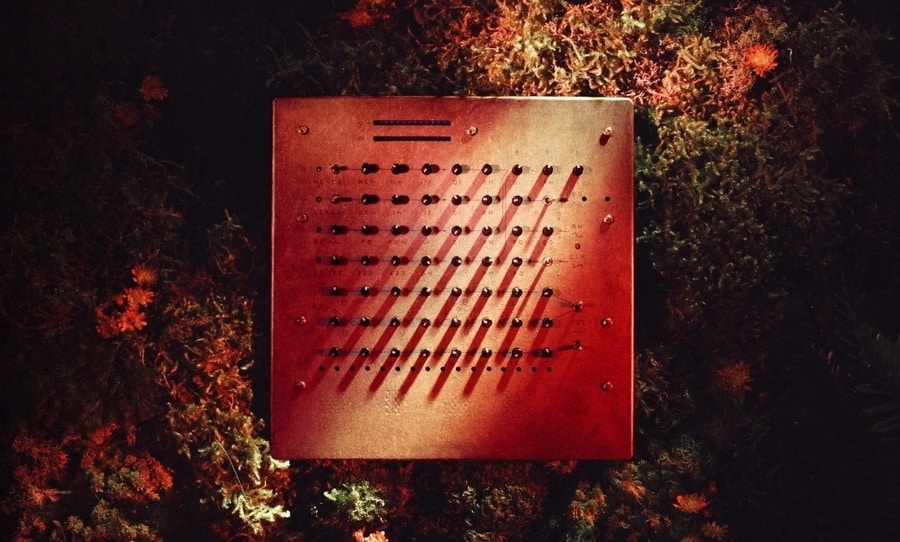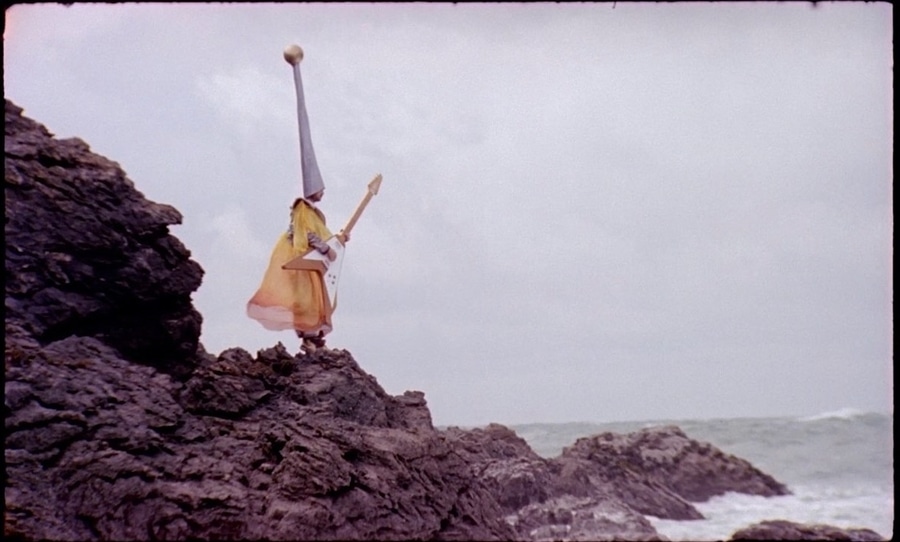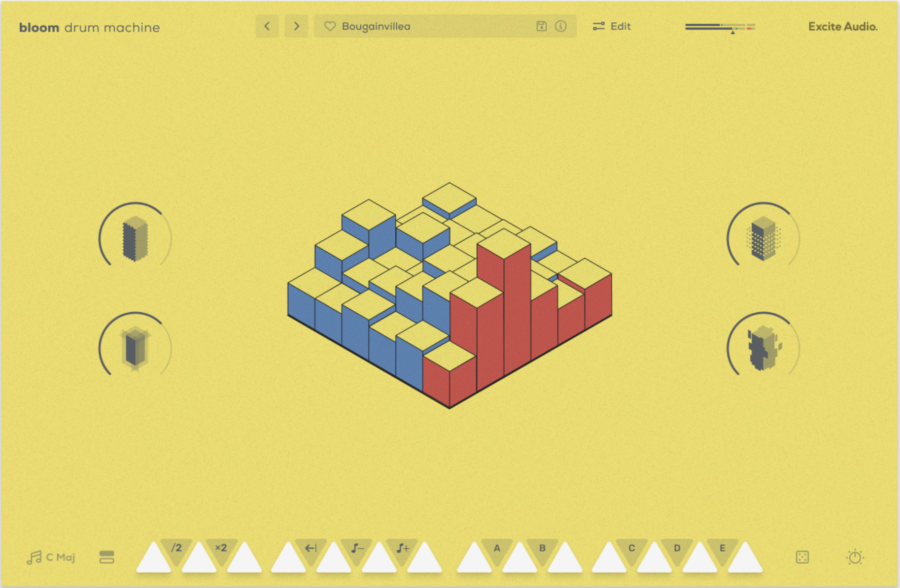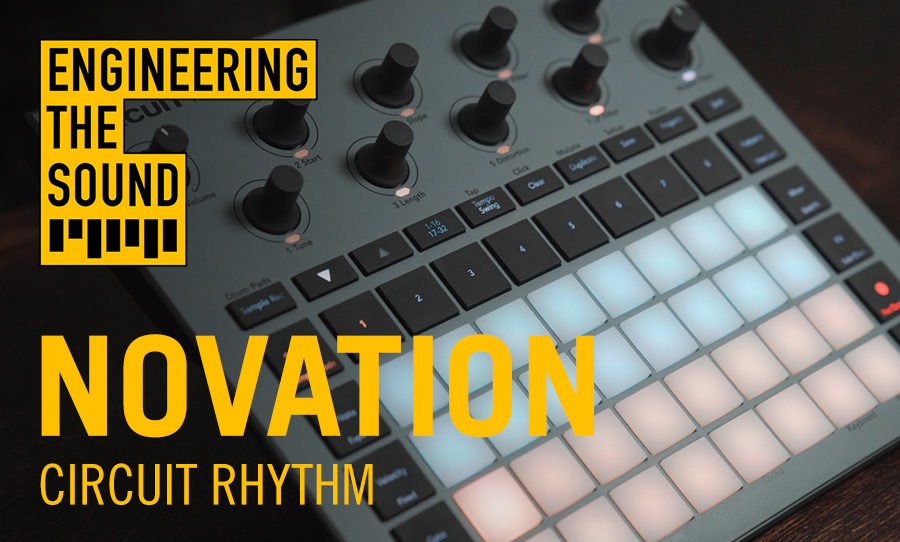The new album from LA Priest, GENE, drops on June 5. The story behind it is as surprising and unique as the songwriter and performer Sam Eastgate himself, who first came on the map in the mid-2000s with his band Late of the Pier. Since then he has made two solo albums, as well as collaborated with Connan Mockasin in their duo Soft Hair and with Franz Ferdinand on their 2018 album Always Ascending.
To write and record GENE, Eastgate made his own drum machine, soldering in his shed for two years to make the instrument that the album is named after. The process was motivated by the fact that Eastgate found most drum machines to be too limited, and he designed the instrument so the drum machine would sound more like a real drummer – he could make it go out of time when he wanted.
GENE (the album) is full of lush falsettos, sprawling guitars, and beats that are uncannily off-kilter. You wonder ‘have I heard something like this before?’ as the slinky arrangements pull you lightly along. The approach is stealthy and delicate.
In subtle ways, GENE deals with ideas like creation, growth, and the elasticity of human beings, which ties in with the multiple types of creation that go into the album. It asks, in a genuinely new way, are humans more machine or organism? What’s the difference?
In this interview, I talk to LA Priest about the creation of the GENE album and machine, and making electronic music sound organic. We also talk about how Eastgate negotiates the organic and the industrial in his music videos, as well as the limitations of live streaming.

We spoke with LA Priest aka Sam Eastgate (Late of the Pier, Soft Hair), ahead of the release of his album GENE out on June 5th.
HAPPY: Your newest album, GENE, was named after the drum machine you built to write and record the tracks. How did you go about designing the machine?
LA PRIEST: I had a few things to lay down the foundation of a song when I was recording the first album. I would use a sampler sometimes and try to make it my own as much as possible, put my own drum samples in, and there was always this kind of rigidity to it.
So I just needed to look at that, like ‘how can I make this a bit more lively’, and the first step was to rethink the sequencer of it so that it’s not this grid, because with all drum machines – they’re very gridded. You get one human element with them, which is your swing, which shifts all the off-beats, and I thought I needed to change that, because I know from recording real drummers and doing my own experiments that most of the time the best sounding rhythms have these beats just all over the place, way off what you would call a grid.
The main bit was reinventing that and making sure that the sequencer could position these beats wherever you like. It was just about making the loop linear so you could sweep across and you could find the exact sweet spot for your snare drum or whatever drum. And after that I thought I’ll keep making it all kind of unique; it would be a shame after that to stick somebody else’s bass drum on it, so I got carried away with it.

HAPPY: How exactly does it work? Looking at it, it doesn’t look like it has an 808-style grid or anything.
LA PRIEST: The way that the sequencer works is that you can have as many beats as you like up to 16 beats, and on the top half you’re turning these dials to choose which drum plays on that beat. You can also have those run in parallel so you can layer stuff, and instead of pressing buttons, you’re selecting the drums.
The real interesting bit is below that – you have another eight controls and each of those dials is really just how on the grid or off the grid those beats are. If you have those to the left, it’s not dead-on, but you get very close to a grid, and the more you turn those, the more they go off; I think it’s up to three or four beats that they can be late. Sometimes you can get really confusing things happening where you’ve turned those beats so far that they’re later than the one after them.
HAPPY: On one of the singles, What Moves, it seems like there’s a lot of changes in BPM. Did you have any challenges recording while you were working with this sort of volatile drummer?
LA PRIEST: Yeah, that’s one of the most obvious effects [of the GENE]. I think in Beginning I forgot that I looped something and it ended up being perfectly on the grid, so it was really weird because I was warning Erol [Alkan, mix engineer for LA Priest and Late of the Pier] when he came to mix it that it’s all way off. I don’t know what happened; it was something accidental.
Because of how it runs, it runs off a single capacitor – basically like a little blob of two bits of metal sandwiched together, sitting inside the drum machine – it changes with heat. It changes its nature depending on how it’s being used in the circuit, so if you have the drum machine in the standby position, it’s cooling down.
This wasn’t intentional, but generally what happens, as a result, is the tracks speed up by a couple of BPM throughout the recording, which is actually really close to what a real drummer or a band would do when they’re playing live. This is all the kind of stuff they wanted to weed out when the digital revolution happened in the late ’80s, they were trying to get rid of all these inconsistencies.
HAPPY: You’re bringing a bit of that organic thing back into it.
LA PRIEST: Yeah, and that was a really happy accident. There’s a lot of things where you bring back that vibe – of a human [laughs].
HAPPY: Were you inspired by any other drum machines? I hear some 909-esque sounds.
LA PRIEST: I used to think the 909 was amazing when I was a teenager, when I was 12 or 13. I thought if I had one of those I could make any sort of music I liked, or I had those ideas that this equipment has all the magic in it. It’s funny because if I bought one back then it would have cost me a couple of hundred quid, they’re like three grand or four grand now.
Then I ended up hating that sound when I was about 20, that was the bit where I was like ‘I could never use anything like that on a song,’ and I think when you come down to it and you have to choose your own set of sounds, you sort of start to just borrow from everything.
I think I realised that if I just tried to make it sound like whatever I was doing right then, it would age really quickly and I would hate it, you know, if I just went ‘these are the sounds that I like right now.’ So I really intentionally tried to make it do a range and make it so each sound has maybe one or two controls and each sound can sweep through a variety of tones.
HAPPY: Is it important for you to have your own sonic signature and have your own take, not only on melody and harmony but also tones?
LA PRIEST: That’s sort of an interesting point. Sometimes I think a song is a song and it’s going to carry it, and the sounds don’t always matter that much. Weirdly enough I write ideas based on the tiniest little details in the sound. The way that I work is I hear ideas in the sounds, there can be a really subtle change [that inspires me]. So it’s more the recording process. With GENE, you could swap out all of that with a 909 or a real drum kit and most people wouldn’t notice. So it’s more for the other side, it’s more for the recording and the writing.

HAPPY: I really love the costuming on that video [for Beginning]. Some people are comparing it to Monty Python, some to Depeche Mode’s Enjoy the Silence. How did you come up with it and how did you come to collaborate with [costume designer] Desiree Laidler?
LA PRIEST: I sent a really specific brief to her, and it was like a collage that I made of me with; I think the bottom half was a photo of Sun Ra, and my head and some stuff around the collar I had added on, and these spheres I had added on my head, and really that idea came up just because I was just going to make this alien thing.
And mostly that video is inspired by something we used to watch years ago, from this guy we toured with a bit called Mickey Moonlight, and he had a video for Interplanetary Music. And this was before I’d seen Enjoy the Silence or anything like that, and that video is probably inspired by the Depeche Mode one but it’s just him walking around with this pointy hood and this gold cloak in the desert. Quite a minimal video really.
It came from the idea that I wanted to be in the video, because I’d just done a video that was totally animated, and I thought people might want to see the artist and who’s behind it. But I thought I other go one way or the other: I could kind of try and portray this kind of ‘cool,’ but I realised I don’t really want to try and do that, so I should just go completely the other way and make myself look kind of as foolish as possible and be obvious that I’m not trying to be cool [laughs].
And I don’t know, maybe some people think that is cool, but for me, I laughed at myself. When I saw myself in the mirror I was like ‘that’s the effect I want,’ I want to look absolutely ridiculous.
HAPPY: It lets you go in both directions. Your presence isn’t there as much – you could just appear as you but you’ve got this outrageous hat on that obscures your face.
LA PRIEST: It’s kind of like that hat that they put on kids who’ve been naughty and they have to go sit in the naughty corner. It’s another celebration of the outsider or the reject or something.
With Desiree, she made this amazing hat but it just wouldn’t stay on because it was made of these spheres. I had to wear this crazy thing with all these straps around my face, I think it was made out of a Viking helmet and it ended up just weighing a ton. The morning of the shoot I was thinking ‘I don’t know what I’m going to do.’ It was kind of depressing ’cause I didn’t have anything to wear.
So it was about six in the morning, we were about to drive and do these shoots around where I live and I pulled this thing out of the back of my shed, it was this huge sheet of plastic that you’re supposed to cover the floor with when you’re moving house, and I rolled it up really quickly while everyone was packing the camera gear. The silver from it is just the duct tape I used to wrap it up with.
HAPPY: I would never have guessed.
LA PRIEST: It was really lucky because it could have looked awful. I mean it doesn’t look perfect, let’s put it that way, but it could have looked worse, with the ball stuck on top.
HAPPY: I really love both of those videos; they’re sort of playing with this whole thing about, like organic and industrial. You’ve got the really metallic looking costume in the Beginning video, against the backdrop of the sort of pastoral Welsh landscape. And in the other one [What Moves] there’s this animated organism growing. To me, that resonates with the whole album and this thing of making the electronic sound organic. Was that a big thing for you?
LA PRIEST: I think it’s amazing how humans, myself included, can live in a very kind of, let’s say clinical environment for a very long time without realising what the kind of missing thing is. But I think that everybody, we all benefit from the kind of curves and the kind of organic qualities of natural things. Sometimes we have to remember to include them in our lives.
I can listen to precise digital music and sit in a room with no plants and find things to do and not feel I’m trapped, and I think most people are like that. We don’t have an instant reaction to being separated from the natural world. For me, I know that it just feels better. It feels better for your soul to have. I think it’s the imperfection, you know? I don’t know why we react so well to it, but it keeps you sane for some reason [laughs].
HAPPY: All this talk about clinical spaces leads me into my last question which was how are you coping with all the coronavirus stuff? Is your tour still going ahead in October?
LA PRIEST: Yeah that’s the plan. I mean, it would be funny if I had some inside information about it but sadly I don’t. I mean for me it’s not that different. The funny thing for me was that I’d been planning this thing of touring again for a few years.
It was very, very close to happening, and while I was annoyed and frustrated by this sudden thing that everybody was experiencing as well, the thing for me was I was excited about a change in my life and everything was staying the same. I was just going to have to stay at home and do more of the same. Whereas other people were in a much worse situation where their life would change uncontrollably. They were going to be sad because their stable existence was going to be taken from underneath them.
As soon as I had gotten my head around that it was like ‘oh, I’m just upset because I had this exciting voyage around the world in my head and it is going to happen one day soon, maybe.’ So it only took a few days to kind of put that into perspective, and I was like ‘I’ll get back to work, doing what I do best.’
HAPPY: How do you feel about live streaming ? Is it a viable alternative to performing for you at the moment?
LA PRIEST: For me it’s not. I guess it goes with everything else that I talk about with the kind of atmosphere of everything that is real and natural. That is not totally my cup of tea, let’s say. But I think about how I would have approached this starting out when there wasn’t any of this technology, when I started at about 16, 17.
You couldn’t do that kind of thing really. You couldn’t do a livestream of a concert. I think if that had been an option back then I would have jumped at the chance and I would have thought about it as a totally new opportunity.
I think I’ve really grown into the real, live thing just more and more and I suppose it took this for me to realise how kind of tuned-in I am to a crowd when I’m actually in front of them, and that was really a kind of very alien thing to do, to be playing to a crowd and not feeling all of those kinds of like reactions.
It’s almost like the air just changes; it’s like the temperature, the air or something. Just this weird subconscious thing where you feel what the crowd thinks almost in every part of the song; you go up and down with them. And I don’t know how you could reinject that, it’s definitely really hard to get that sense. You’d have to keep looking at the chat or whatever [laughs].
HAPPY: Yeah [laughs]. I think the problem is that people are trying to recreate that energy, where really they should just try to turn it into a TV show or something. I think Radiohead was one of the first bands to livestream, in 2002 or something, and they just turned their livestream into effectively a TV show, rather than trying to assume any intimacy.
LA PRIEST: Yeah that’s it. That’s kind of what I realised, and that again goes back to how I would have approached it, if it was around when I was a teenager. Firstly, I wouldn’t have known what it was like to play in front of a crowd at that stage, anyway, but secondly, I would have been like ‘well, let’s see what this is, what is the nature of this.’ That’s where I want to go next with it, go into whatever world that is.

HAPPY: One of the more clever ways I’ve seen any artist engage with fans online was the GENE Machine website, where people can actually play a simulated version of the GENE drum machine. Was that hard to set up?
LA PRIEST: I just gave all the artwork, files and the separate parts for the songs, all the kind of materials to this group of designers who had done kind of similar things before. But they wanted to build it just as a mixer, so you could turn up different parts of the song. I was saying, if we’re going to do it, I want it to feel more like you can hear something you wouldn’t before. You can change the arrangements so you hear things and sections you wouldn’t hear in the song naturally.
It runs on a webpage and it doesn’t take up a lot of memory or internet so I guess it’s pretty good for what it does. I always want to go further with that kind of stuff and I kind of see it just developing into something that’s a little bit more immersive, that has another level beyond that. A bit like, I don’t know if you ever saw the website for the last album, but that really felt like more kind of exciting in a way cause it was this weird landscape of different pages.
That just didn’t work in the end because all the internet browsers got updated so you can’t even play multiple windows. The way that that worked, it was only really applicable to whatever we were on at the time, JavaScript or whatever it was.
HAPPY: Thanks so much for your time, Sam. I hope you’re able to come out to Australia sometime soon. It might take a year!
LA PRIEST: Yeah me too. Whenever we’re allowed out, I think that will happen really soon after that because I think I even had some stuff in the pipeline!
LA Priest’s album GENE is out June 5 via Domino.


